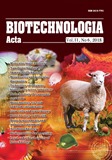ISSN 2410-776X (Online)
ISSN 2410-7751 (Print)

Biotechnologia Acta, V. 11, No 6, 2018
https://doi.org/10.15407/biotech11.06.047
Р. 47-54, Bibliography 25, English
Universal Decimal Classification: 57.023: 58.039
NANOSTRUCTURED FERRIC CITRATE EFFECT ON Chlorella vulgaris DEVELOPMENT
N. B. Golub1, M. Tsvetkovych1, I. I. Levtun1, V. I. Maksyn2
1National Technical University of Ukraine “Igor Sikorsky Kyiv Polytechnic Institute”
2National University of Life and Environmental Sciences of Ukraine, Kyiv
The aim of the research was to study the development of Chlorella vulgaris at culturing on the modified Gromov 6 medium with high concentrations of nanostructured ferric citrate and also its effect on photosynthesis pigments accumulation. It was demonstrated that the highest intracellular iron content (15 mg/g of dry mass) in the culture cells was typical with nanostructured ferric citrate content of 30 mg/dm3 of culture medium, the highest content of chlorophyll a — 23 mg/g of dry algae mass, b — 7.5 mg/g of dry mass, and carotenoids — 9.2 mg/g of dry mass was observed at nanostructured ferric citrate content of 20 mg/dm3. The use of nanostructured ferric citrate leaded to an increase in the chlorella biomass yield by 3 times with compared to standard technology. Simultaneously, intracellular iron content in cells increased significantly with the use of nanostructured ferric citrate, which increases their value as a nutritional supplement. In order to increase the biomass yield and intracellular iron content in cells, application of nanostructured ferric citrate is recommended.
Key words: chlorella cells, biomass, intracellular iron, chlorophylls, carotenoids, nanostructured ferric citrate.
© Palladin Institute of Biochemistry of National Academy of Sciences of Ukraine, 2018
References
1. Iriani D., Suriyaphan O., Chaiyanate N. Effect of iron concentration on growth, protein content and total phenolic content of Chlorella sp. cultured in basal medium. Sains Malaysiana. 2011,40 (4), 353–358.
2. Anderson R. A. Algal culturing techniques. Amsterdam: Elsevier Academic Press. 2005, P. 429–538.
3. Andreichev N. A., Baleyeva L. V. Irone deficiency and iron deficiency anemia. Mod. Clin. Med. 2009, 3 (2), 60–65. (In Russian).
4. Upitis V. V. Macro- and mikroelements in optimization mineral power microalgae. Riga. 1983, P. 240. (In Russian).
5. Imamoglu E., Sukan E. F. V., Dalay M. C. Effect of different culture media and light intensities on growth of Haematococcus pluvialis. Int. J. Nat. Engin. Sc. 2007, 1 (3), 5–9.
6. Battah M. G., El-Ayoty Y. M., Esmael A. E., Abd El-Ghany S. E. Effect of different concentrations of sodium nitrate, sodium chloride, andferrous sulphate on the growth and lipid content of Chlorella vulgaris. J. Agricult. Technol. 2014, 10 (2), 339–353.
7. Yuan J. P., Chen F., Liu X., Li X. Z. Carotenoid composition in the green microalga Chlorococcum. Food Chem. 2002, V. 76, P. 319–325. https://doi.org/10.1016/S0308-8146(01)00279-5
8. Liu Z. Y., Wang G. C., Zhou B. C. Effect of iron on growth and lipid accumulation in Chlorella vulgaris. Bioresour. Technol. 2008, V. 99, P. 4717–4722. https://doi.org/10.1016/j.biortech.2007.09.073
9. Carpio R-B., De Leon R-L., Martinez-goss M-R. Growth, lipid content, and lipid profile of the green alga, Chlorella vulgaris beij., under different concentrations of Fe and CO2. J. Engin. Sci. Technol. 2014, P. 24–25.
10. Kharchenko O. O. Estimation of bioavailability of zinc, magnesium and iron citrates obtained by aquanotechnology. Inter. seminar “Ethics of nanotechnologies and nano-security”. 2011, P. 47–48. (In Ukrainian).
11. Kharchenko O. O. Citrats of biometals — as an alternative to solving the problem of macro and microelemental deficiency. Hygiene of populated places. 2012, N 60, P. 242–247. (In Ukrainian).
12. Golub N. B., Levtun I. I. Influence of light energy wave leneght on cultivation of Chlorella vulgaris. National University “Lviv Polytechnic”. 2016, V. 841, P. 138–144.
13. Golub N. B. Scientific and technological bases of conversion of renewable raw materials into biomass, biomethane and biodiesel. Kyiv: Igor Sykorsky KPI. 2015, P. 437. (In Ukrainian).
14. Nayek S., Haque C. I., Nishika J., Suprakash R. Spectrophotometric analysis of chlorophylls and carotenoids from commonly grown fern species by using various extracting solvents. Res. J. Chem. Sci. 2014, 4 (9), 63–69.
15. Drinking water. Methods of measuring the mass concentration of total iron. Measurement of the mass concentration of total iron with sulfosalicylic acid. 4011–4072. (In Russian).
16. Estevez M. S., Malanga G., Puntarulo S. Iron-dependent oxidative stress in Chlorella vulgaris. Plant Sci. 2001, V. 161, P. 9–17. https://doi.org/10.1016/S0168-9452(01)00364-8
17. Kothamasi D., Kothamasi S. Cobalt interference in iron-uptake could inhibit growth in Pseudomonas aeruginosa. World J. Microbiol. Biotechnol. 2005, V. 20, P. 755–758. https://doi.org/10.1007/s11274-004-5810-4
18. Kaplan D. Absorption and adsorption of heavy metals by microalgae. Handbook of Microalgal Culture: Applied Phycology and Biotechnology. 2013, V. 2, P. 602–611. https://doi.org/10.1002/9781118567166.ch32
19. Das N., Vimala R., Karthika P. Biosorption ofheavy metals — an overview. Ind. J. Biotechnol. 2008, V. 7, P. 159–169.
20. De Philippis R., Colica G., Mecarozzi P. Exopolysaccharide-producing cyanobacteria in heavy metalremoval from water: molecular basis and practical applicability of the biosorption process. Appl. Microbiol. Biotechnol. 2011, V. 92, P. 697–708. https://doi.org/10.1007/s00253-011-3601-z
21. Mishra A., Kavita K., Jha B. Characterization of extracellular polymeric substances produced bymicro-algae Dunaliella salina. Carbohydr. Polym. 2011, V. 83, P. 852–857. https://doi.org/10.1016/j.carbpol.2010.08.067
22. Naja G., Volesky B. The mechanism of metal cationand anion biosorption. Microb. Biosorption Met. 2011, P. 19–58.

